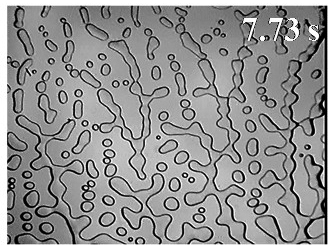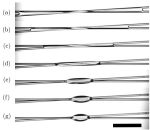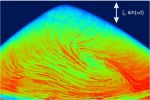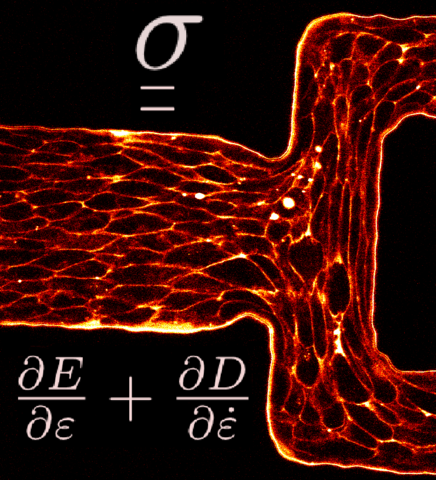EPJ E Highlight - When liquids get up close and personal with powders
- Details
- Published on 01 March 2016

Scientists leave no stone unturned when studying how a liquid wets a powder
Every cook knows that dissolving powder into a liquid, such as semolina in milk or polenta in water, often creates lumps. What they most likely don’t know is that physicists spend a lot of time attempting to understand what happens in those lumps. In a review paper published in EPJ E, scientists from the École Supérieure de Physique et de Chimie Industrielles de la Ville de Paris (ESPCI), France, share their insights following ten years of research into the wetting of soluble polymer substrates by droplets of solvents like water.
EPJ E Highlight - Adjustable adhesion power: what fakirs can learn from geckos
- Details
- Published on 23 December 2015

New study models adhesion force as key to contact between two rough, yet elastic, surfaces
Imagine a new type of tyres whose structure has been designed to have greater adhesion on the road. Quite a timely discussion during the long winter nights. French physicists have now developed a model to study the importance of adhesion in establishing contact between two patterned, yet elastic, surfaces. Nature is full of examples of amazing adjustable adhesion power, like the feet of geckos, covered in multiple hairs of decreasing size. Until now, most experimental and theoretical studies have only focused on the elastic deformation of surfaces, neglecting the adhesion forces between such surfaces. This new approach just published in EPJ E, by Laetitia Dies and colleagues from the Paris Sud University, France, matters when the scale of adhesive forces, is comparable to elastic forces on materials such a tyres.
EPJE Colloquium: Dense granular flows - fluidity revisited
- Details
- Published on 28 November 2015

Bouzid et al.
In this new EPJ E Colloquium, a group of authors from ESPCI, Univ. Paris-Diderot and Univ. P.M. Curie use the interpretive frame-work of non-locality to describe the rheology and fluidity in dense granular flows. Is a “good fitting” of the velocity profiles sufficient to demonstrate the validity of a particular model for non-locality?
EPJ E Highlight - Liquid foam: plastic, elastic and fluid
- Details
- Published on 27 November 2015

Snapshots of the foam at the exit of the convergent channel
What differentiates complex fluids from mere fluids? What makes them unique is that they are neither solid nor liquid. Among such complex fluids are foams. They are used as a model to understand the mechanisms underlying complex fluids flow. Now, a team of French physicists has gained new insights into predicting how complex fluids react under stretching conditions due to the interplay between elasticity, plasticity and flow. These findings were recently published in EPJ E by Benjamin Dollet and Claire Bocher from the Rennes Institute of Physics, in Brittany, France. Ultimately, potential applications include the design of new, optimised acoustic insulators based on liquid forms, or the mitigation of blast waves caused by explosions.
EPJ E Highlight - Zooplankton: not-so-passive motion in turbulence
- Details
- Published on 10 November 2015

Physicists show that despite their limited swimming abilities, zooplankton called calanoid copepods display active, energetic behaviour in turbulent flows
Imagine a species that is only one millimetre long and has only a limited swimming ability. Yet, its mobility is sufficient for moving, feeding and reproducing in freshwater and seawater. That’s exactly what a type of zooplankton of the crustaceans family - namely the calanoid copepods - does. In a study published in EPJ E, physicists shed new light on how these zooplankton steer large-scale collective motion under strong turbulence. To do so, the authors study the zooplankton’s small-scale motion mechanisms when subjected to background flow motion. These findings are the work of François-Gaël Michalec from the Institute of Environmental Engineering, ETH Zurich, Switzerland, and European colleagues. Ecological applications in the field of zooplankton behaviour ecology include, for example, modelling the feeding efficiency of their predator, fish larvae.
EPJ E Colloquium: Adhesion induced pattern formation in constrained soft films
- Details
- Published on 31 July 2015

© Chaudhury et al.
A hydrostatically-stressed soft elastic film responds by developing a morphological instability, the wavelength of which is dictated by minimisation of the surface and elastic strain energies of the film. For a single film, the wavelength of this transition is entirely dependent on the film's thickness, however in the case of two contacting films a co-operative energy minimisation dictates that the wavelength depends on both the elastic moduli and the thicknesses of the two films.
EPJ E Highlight - Improving insulation materials, down to wetting crossed fibres
- Details
- Published on 30 June 2015

Scientists model the manner in which a liquid wets fibres, gaining useful insights for improving glass wool properties
Sandcastles are a prime example of how adding a small amount of liquid to a granular material changes its characteristics. But understanding the effect of a liquid wetting randomly oriented fibres in a fibrous medium remains a mystery. Relevant to the building industry, which uses glass wool, for instance, this phenomenon can be better understood by studying the behaviour of a liquid trapped between two parallel fibres. It can either remain in the shape of a drop or spread between the fibres into a long and thin column of liquid. Now, scientists have demonstrated that the spreading of the liquid is controlled by three key parameters: the amount of liquid on the fibres, the fibres’ orientation and the minimum distance between them. These findings, based on experimental and modelling work, were recently published in EPJ E. The authors are Alban Sauret, a scientist working at a laboratory jointly operated by the CNRS and Saint-Gobain, a building materials manufacturer in France, and international colleagues based at Princeton University and the NYU School of Engineering, USA.
EPJ E Colloquium - The role of acoustic streaming in vertically vibrated granular beds
- Details
- Published on 30 June 2015

A recent EPJ E Colloquium by Jose Manuel Valverde looks at the fundamental physics that causes convection and fluidization in vibrated beds of particles with large inertia. The author examines the question of whether acoustic streaming arising from oscillatory viscous flows might play a role on the onset of convection and fluidization in vertically vibrated granular beds.
Acoustic streaming, first observed by Faraday in 1831, is an enigmatic phenomenon that has puzzled physicists for a long time. It occurs when a viscous fluid oscillates in the presence of a solid boundary. The dissipation of energy by viscous friction leads to a secondary steady circulation of fluid in a boundary layer near the surface of the solid, which enhances the gas-solid viscous interaction. Granular beds display, at sufficiently high vibrational intensities, surface patterns that bear a stunning resemblance to the surface ripples (Faraday waves) observed for low viscosity liquids. This suggests that the granular bed transits to a liquid-like regime, despite the large inertia of the particles.
EPJ E Highlight - How supercooled water is prevented from turning into ice
- Details
- Published on 20 May 2015

Calculating the energy barrier that keeps liquid water below zero from immediately turning into ice provides the key to understanding its ability to be compressed as temperature drops
Water behaves in mysterious ways. Especially below zero, where it is dubbed supercooled water, before it turns into ice. Physicists have recently observed the spontaneous first steps of the ice formation process, as tiny crystal clusters as small as 15 molecules start to exhibit the recognisable structural pattern of crystalline ice. This is part of a new study, which shows that liquid water does not become completely unstable as it becomes supercooled, prior to turning into ice crystals. The team reached this conclusion by proving that an energy barrier for crystal formation exists throughout the region in which supercooled water’s compressibility continues to rise. Previous work argued that this barrier vanished as the liquid gets colder. These findings have been published in EPJ E by Connor Buhariwalla from St. Francis Xavier University in Antigonish, Canada and colleagues.
EPJ E Colloquium – The importance of rheology in tissue development
- Details
- Published on 20 May 2015

Our understanding of biomechanics increasingly improves through the use of physics models. There are some intriguing biological questions regarding the interplay between the behaviour of cells and the mechanics at the level of tissues. For example, how does a collective behavior, not apparent at the cell scale, emerge at the tissue level? Or how can the mechanical state of a tissue affect the cell division rate or the orientation of cells undergoing division?
The authors of this new EPJ E Colloquium entitled “Mechanical Formalism for Tissue Dynamics” think that the interplay between genes and mechanics is key to understanding how the adult shape emerges from a developing tissue.





